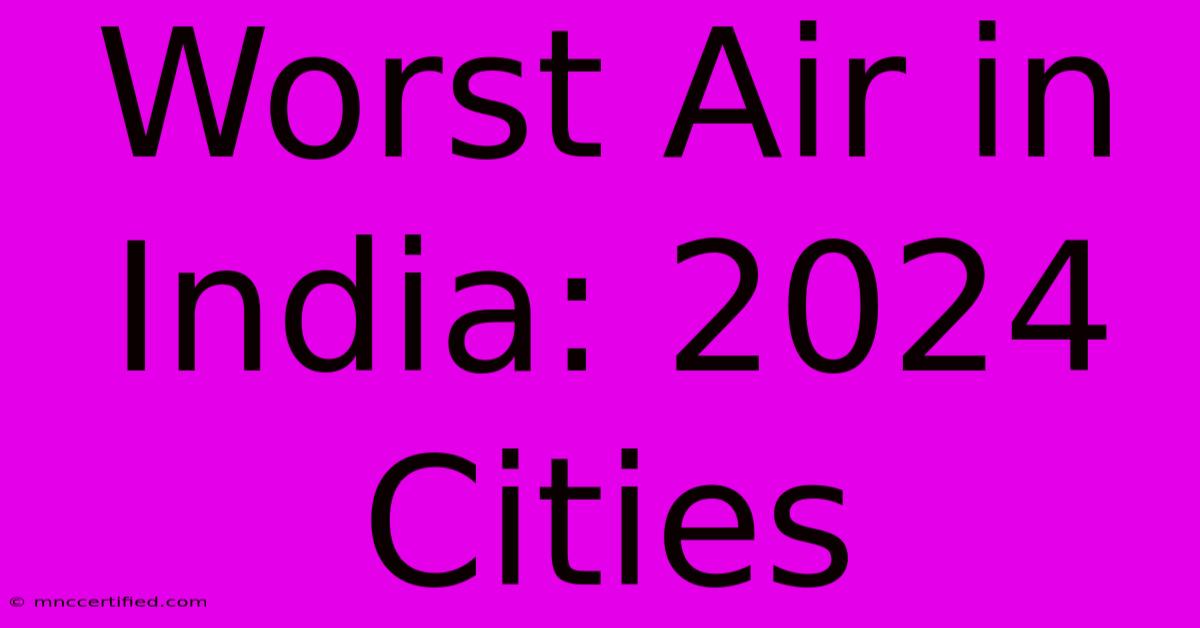Worst Air In India: 2024 Cities

Table of Contents
Worst Air in India: 2024's Most Polluted Cities
India's air quality remains a pressing concern, impacting public health and the environment. While the government implements various initiatives to combat pollution, many cities continue to grapple with dangerously high levels of air pollutants. This article identifies some of the cities with the worst air quality in India in 2024 (based on projections and current trends, as real-time data fluctuates), offering insights into the contributing factors and potential solutions. It's crucial to remember that air quality can change rapidly and these rankings are a snapshot based on available information. Always consult up-to-date resources for the most current data.
Understanding the Air Quality Index (AQI)
Before delving into the list, it's important to understand the Air Quality Index (AQI). The AQI measures the concentration of various pollutants in the air, providing a single number representing the overall air quality. A higher AQI indicates worse air quality and greater health risks. Generally, an AQI above 100 is considered unhealthy for sensitive groups, while above 300 is considered hazardous for everyone.
Cities with Consistently Poor Air Quality (Projected 2024)
Several Indian cities consistently rank among the most polluted globally and are projected to remain so in 2024. These include, but are not limited to:
1. Delhi: A Persistent Problem
Delhi, India's capital, frequently tops the lists of most polluted cities. A combination of factors contributes to this, including:
- Vehicular emissions: The high density of vehicles, particularly older models, releases significant amounts of pollutants.
- Construction and demolition activities: Dust from construction sites adds to particulate matter pollution.
- Industrial emissions: Industries located within and around Delhi contribute to the overall pollution levels.
- Agricultural burning: Crop residue burning in neighboring states significantly impacts Delhi's air quality, particularly during certain seasons.
- Seasonal factors: Meteorological conditions, such as temperature inversions, can trap pollutants near the ground.
Improving Delhi's air quality requires a multi-pronged approach focusing on stricter emission standards, promoting public transport, and controlling construction activities.
2. Mumbai: A Growing Concern
While not as consistently severe as Delhi, Mumbai's air quality is deteriorating, largely due to:
- Increased vehicular traffic: Rapid urbanization and a growing population lead to increased congestion and emissions.
- Construction boom: Extensive construction projects contribute to significant dust pollution.
- Industrial activities: Industrial zones around Mumbai release pollutants into the atmosphere.
Mumbai needs to invest heavily in sustainable transportation, stricter building regulations, and improved industrial emission controls.
3. Kolkata: A Complex Scenario
Kolkata's air pollution is a complex issue influenced by:
- Industrial emissions: The city's industrial heritage contributes to high levels of pollutants.
- Traffic congestion: Similar to other major cities, traffic congestion is a major source of air pollution.
- Burning of solid waste: Improper waste management contributes to air pollution.
Addressing Kolkata's air pollution requires efficient waste management systems, improved industrial regulations, and sustainable transportation solutions.
Other Cities Facing Significant Air Pollution Challenges (Projected 2024)
Many other Indian cities are grappling with significant air pollution challenges, including:
- Gurugram: Often ranked among the most polluted, suffering from similar issues as Delhi.
- Noida: Shares similar pollution challenges as Delhi and Gurugram.
- Lucknow: Rapid urbanization and industrial growth exacerbate air pollution.
- Patna: High population density and industrial activities contribute to poor air quality.
- Kanpur: Industrial emissions and vehicular pollution are major contributors.
These cities need to prioritize sustainable urban planning, stricter emission norms, and improved public awareness campaigns to effectively address their air pollution problems.
Addressing India's Air Pollution Crisis
Combating India's air pollution crisis requires a holistic approach involving:
- Stronger regulations and enforcement: Stricter emission standards and consistent enforcement are vital.
- Investing in public transportation: Promoting public transport reduces reliance on private vehicles.
- Renewable energy adoption: Transitioning to renewable energy sources reduces reliance on fossil fuels.
- Sustainable urban planning: Careful urban planning can minimize pollution sources.
- Public awareness campaigns: Educating citizens about the impact of air pollution and ways to reduce their contribution.
- Technological advancements: Utilizing advanced technologies for pollution monitoring and control.
Addressing India's air pollution is a crucial step towards ensuring the health and well-being of its citizens and the sustainability of its environment. Continuous monitoring, effective policy implementation, and public participation are essential to achieve significant improvements in air quality across the country. The projections for 2024 highlight the urgency of tackling this issue effectively. Remember to consult official sources for the most current AQI data for specific cities.

Thank you for visiting our website wich cover about Worst Air In India: 2024 Cities. We hope the information provided has been useful to you. Feel free to contact us if you have any questions or need further assistance. See you next time and dont miss to bookmark.
Featured Posts
-
Carpenters Union Vision Insurance
Nov 19, 2024
-
Utah Thanksgiving Dinner Where To Go
Nov 19, 2024
-
Megalodon Teeth Yield 26 Billion Minerals
Nov 19, 2024
-
State Farm Boat Insurance Reviews
Nov 19, 2024
-
Get Sidemen Fc 2025 Match Tickets
Nov 19, 2024